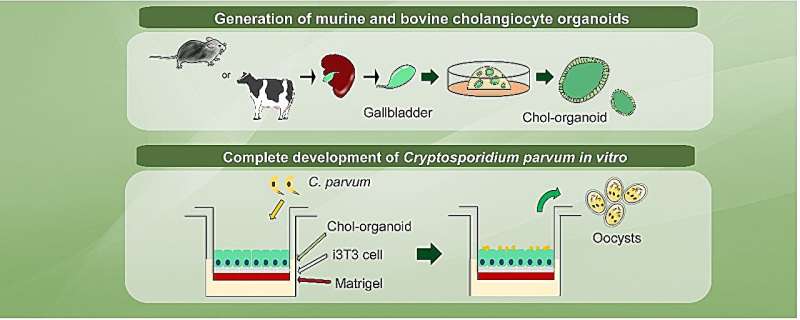This article has been reviewed according to Science X's editorial process and policies. Editors have highlighted the following attributes while ensuring the content's credibility:
fact-checked
proofread
Team describes simple way to generate mouse and bovine cholangiocyte organoids

In a paper published in hLife, a team of Chinese scientists describes simple procedures for generating mouse and bovine cholangiocyte organoids (Chol-orgs) and establishing an in vitro system for culturing Cryptosporidium and transcriptomic studies of biliary cryptosporidiosis.
This study is led by Prof. Feng (College of Veterinary Medicine, South China Agricultural University) and Prof. Xiao (College of Veterinary Medicine, South China Agricultural University). The team established a culture system for the cultivation of Cryptosporidium parvum derived from mouse and bovine cholangiocyte organoids (Chol-orgs).
Cryptosporidium parvum is a protozoan parasite that causes gastrointestinal disease in humans and animals worldwide. Infection is usually self-limited in immunocompetent individuals, but is a major problem in immunocompromised hosts and a serious health risk in AIDS patients. C. parvum can infect the epithelial cells lining the gallbladder and bile ducts, resulting in sclerosing cholangitis. However, studies of the mechanisms and host-pathogen interactions are severely limited by the lack of accessible cultures and models of biliary cryptosporidiosis.
This team described simple procedures for the generation of mouse and bovine Chol-orgs, and the establishment of an in vitro model of biliary cryptosporidiosis. Chol-orgs expressing stem and biliary cell markers could be maintained for more than three months and stored in liquid nitrogen for more than a year. The Chol-orgs allow the complete development of C. parvum in vitro, producing oocysts that are infectious to mice. In RNA-seq analysis, C. parvum upregulates host immune and inflammatory responses, and downregulates metabolic and signaling pathways involved in cell growth and proliferation.
The results of this study provide a convenient method to study Cryptosporidium-host interactions and biliary cryptosporidiosis. The cholangiocyte organoid culture system will greatly facilitate further studies on the pathogenesis and effective therapies for AIDS cholangiopathy and other liver infections.
More information: Miner Deng et al, A cholangiocyte organoid system for Cryptosporidium parvum cultivation and transcriptomic studies of biliary cryptosporidiosis, hLife (2024). DOI: 10.1016/j.hlife.2024.05.001
Provided by Tsinghua University Press


















